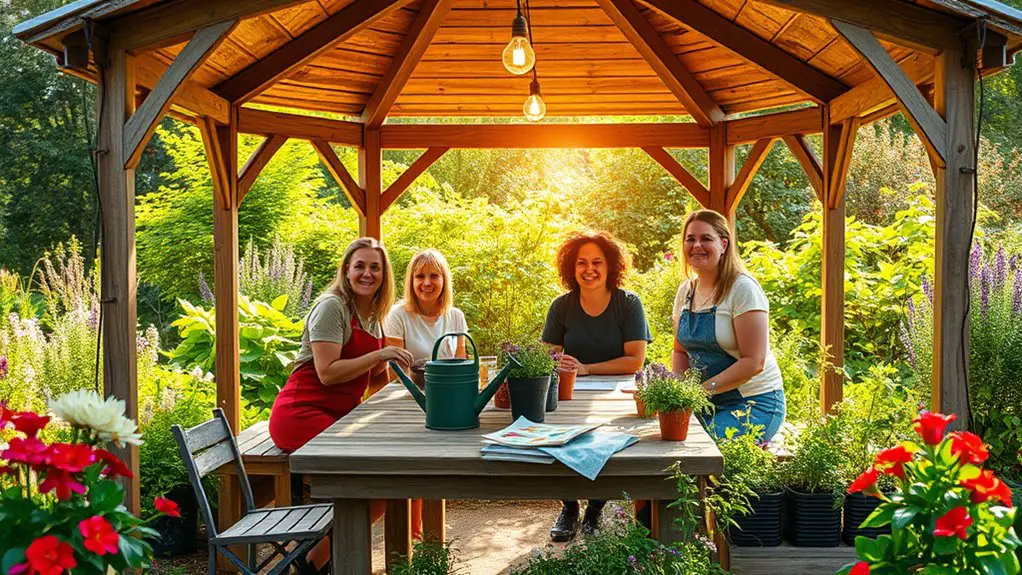To plan your sustainable gardening event in the gazebo, start by picking a convenient date and time, ideally on a weekend. Use eco-friendly materials like biodegradable tableware and natural fabrics. Engage your guests with workshops on seed starting and composting. Create a cozy atmosphere with comfortable seating and soft lighting. Don’t forget to promote your event through social media, engaging the community with updates and tips. There’s plenty more to explore to make your event truly memorable!
Selecting the Right Date and Time
When you’re planning a sustainable gardening event, choosing the right date and time can make all the difference in attracting attendees. First, consider the weather considerations—spring and early fall typically offer mild temperatures that encourage participation. Check local community calendars to avoid conflicts with other events; you want your gathering to stand out. Aim for weekends when folks are more likely to be free and relaxed. Late mornings or early afternoons can be ideal, allowing people to enjoy the fresh air without feeling rushed. Remember, flexibility is key; if unexpected weather pops up, having a backup plan can keep things smooth. By aligning your event with favorable conditions, you’ll create an inviting atmosphere that resonates with your community’s spirit.
Designing an Eco-Friendly Invitation
How can you create an invitation that not only grabs attention but also aligns with your sustainable gardening theme? Embrace eco-friendly design by opting for digital invitations, which save paper and reduce waste. Here are some tips to make your invites stand out:
- Use vibrant visuals of plants and gardens to inspire excitement.
- Incorporate a fun, engaging message that reflects your passion for gardening.
- Consider adding a QR code linking to a website with event details, keeping it interactive.
Choosing Sustainable Materials
Choosing sustainable materials for your gardening event can greatly reduce your environmental impact while enhancing the overall experience. Start by selecting eco-friendly options like biodegradable tableware, recycled decorations, and natural fabrics for seating. Consider using reclaimed wood for tables or displays; it adds character and minimizes waste.
For signage, opt for materials like bamboo or recycled cardboard that can be reused or composted afterward. If you’re providing plant pots, choose biodegradable ones made from materials like peat or coir.
Sourcing Local Vendors and Supplies
When planning your sustainable gardening event, sourcing local vendors and supplies is key to creating a truly eco-friendly atmosphere. You can connect with local farmers for fresh produce, support eco-friendly brands for materials, and collaborate with artisans for unique decor. This not only boosts your community but also guarantees a greener footprint for your event.
Find Local Farmers
Ever wondered where to find the freshest produce and resources for your sustainable gardening event? Connecting with local farmers is crucial, as they provide the best ingredients and knowledge. Here are a few tips to help you find them:
- Visit Farmers Markets: These vibrant spots are perfect for meeting local growers and discovering seasonal produce.
- Engage with Community Networks: Join local gardening groups or social media platforms where farmers often share their offerings.
- Attend Workshops or Events: These gatherings are great opportunities to network with local farmers and learn about their practices.
Sourcing locally not only supports the community but also guarantees your event is sustainable and delicious. Embrace the freedom of fresh, local flavors!
Support Eco-Friendly Brands
Finding local farmers is just the beginning of creating a sustainable gardening event. To amplify your impact, seek out eco-friendly brands that align with your values. Look for vendors who prioritize sustainability in their practices and products. This isn’t just about sourcing supplies; it’s about forming eco-friendly partnerships that enhance your event’s mission. Consider reaching out to local businesses for sustainable sponsorships, which can help cover costs while promoting their commitment to the environment. Engage with brands that offer organic seeds, biodegradable pots, or sustainable gardening tools. By supporting these vendors, you not only bolster your event’s sustainability but also foster a community that values eco-conscious living. Your choices can inspire others to embrace a greener lifestyle.
Collaborate With Artisans
To create a truly memorable sustainable gardening event, collaborating with local artisans can be a game changer. These artisan collaborations not only support the community but also enhance the event’s unique appeal. Building creative partnerships with local vendors can bring a vibrant energy to your gathering.
- Handcrafted decor: Use locally made items to beautify your gazebo and garden space.
- Unique plant offerings: Source native plants from local nurseries for a sustainable touch.
- Artistic workshops: Invite artisans to host hands-on sessions, engaging attendees in creative activities.
Planning Activities and Workshops
When planning activities and workshops for your sustainable gardening event, think about incorporating interactive gardening demonstrations that engage participants directly. Seed starting workshops can empower attendees with hands-on experience, while composting technique sessions will teach them how to recycle organic waste effectively. These activities not only educate but also foster a sense of community among gardening enthusiasts.
Interactive Gardening Demonstrations
Interactive gardening demonstrations offer a fantastic way to engage participants and inspire them to adopt sustainable practices. These hands-on activities allow everyone to learn valuable skills in plant care while enjoying the fresh air. Here are a few ideas to reflect on for your event:
- Container Gardening: Show how to create beautiful, space-saving gardens using pots and recycled materials.
- Composting 101: Teach the basics of composting, emphasizing its benefits for soil health and waste reduction.
- Native Plant Showcase: Highlight local plants, explaining their role in supporting biodiversity and reducing water usage.
Seed Starting Workshops
Have you ever wondered how to get a jumpstart on your gardening while fostering a deeper connection with nature? Hosting seed starting workshops in your gazebo can be the perfect opportunity. Invite local experts to share their knowledge about different seed varieties and the importance of soil health. Participants can learn hands-on techniques for starting seeds indoors, including how to choose the right containers and soil mixes. Encourage them to experiment with heirloom and native seeds, which can thrive in your specific climate. Provide resources, such as planting schedules and care tips, so they leave with confidence. This engaging activity not only empowers your community but also cultivates a shared passion for sustainable gardening. Embrace the freedom of growing your own food!
Composting Techniques Sessions
While many gardeners focus on planting and harvesting, understanding composting techniques can greatly enhance the health of your garden soil. Hosting composting techniques sessions at your gazebo can empower attendees to embrace composting benefits while overcoming common composting challenges. You’ll want to cover various compost methods and the right composting materials to make this workshop engaging and practical. Consider including:
- Hands-on demonstrations of different composting methods like vermicomposting and hot composting.
- Tips on sourcing and balancing composting materials for best results.
- Solutions for common composting challenges, such as odor management and pest control.
Implementing Waste-Reduction Strategies
As you plan your sustainable gardening event, incorporating waste-reduction strategies can greatly enhance its impact. Focus on effective waste management by minimizing single-use items and encouraging recycling initiatives. Here’s a quick guide to help you implement these strategies:
| Strategy | Description |
|---|---|
| Use Reusable Materials | Opt for cloth napkins and plates. |
| Educate Attendees | Share tips on recycling and composting. |
| Set Up Waste Stations | Clearly labeled bins for recycling and composting. |
| Plan for Leftovers | Donate excess food to local shelters. |
Creating a Comfortable and Inviting Atmosphere
Creating a comfortable and inviting atmosphere is essential for a successful sustainable gardening event, especially since it encourages attendees to relax and engage with one another. To enhance the ambiance, consider the following:
- Seating arrangements: Use a mix of comfortable chairs and picnic blankets to create a casual, welcoming vibe.
- Natural elements: Incorporate potted plants and flowers to bring the outside in, enhancing the overall sensory experience.
- Soft lighting: String lights or lanterns can add a warm glow as daylight fades, making the space feel cozy and inviting. Additionally, consider using string twinkle lights to enhance the atmosphere and create a magical setting as the evening progresses.
Promoting Your Event and Engaging the Community
Once you’ve set the stage with a comfortable atmosphere, the next step is getting the word out and connecting with your community. Utilize social media to promote your event and engage locals. Create eye-catching posts, share gardening tips, and encourage community outreach to draw in attendees.
| Platform | Strategy | Audience Engagement |
|---|---|---|
| Event page & updates | Community discussions | |
| Visuals & stories | Polls and questions | |
| Hashtags & quick updates | Real-time interaction | |
| Local Forums | Announcements & resources | Building local connections |
Frequently Asked Questions
How Can I Incorporate Educational Elements Into My Gardening Event?
Imagine your event bursting with vibrant knowledge! You can incorporate workshops sessions for hands-on learning and invite expert panels to ignite discussions. This way, you’ll cultivate an environment where attendees thrive in their gardening journeys.
What Should I Do if It Rains on the Event Day?
If it rains on event day, don’t fret! Have rainy day activities ready, and guarantee you’ve got a backup location. This way, you’ll keep the energy high and everyone’s spirits bright, rain or shine!
How Can I Ensure Accessibility for All Attendees?
To guarantee accessibility for all, think of a welcoming path. Provide wheelchair access and sensory inclusivity, like quiet zones and tactile experiences. It’ll create an environment where everyone can explore and enjoy freely.
What Are Some Eco-Friendly Decorations for My Gazebo?
For eco-friendly decorations, consider using recycled materials like paper lanterns or glass jars. Incorporate natural elements such as flowers, branches, or stones to create a vibrant, inviting atmosphere that aligns with your sustainable vision.
How Can I Measure the Success of My Gardening Event?
To measure your gardening event’s success, focus on feedback collection and participant engagement. Use surveys to gather insights and observe interactions, ensuring you create an enjoyable experience that resonates with attendees and encourages their active participation.

